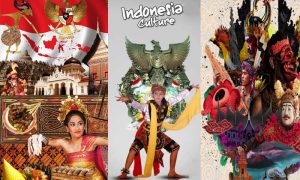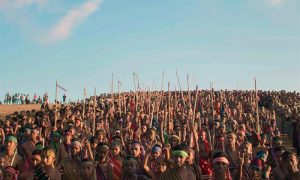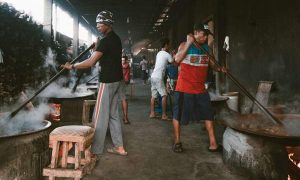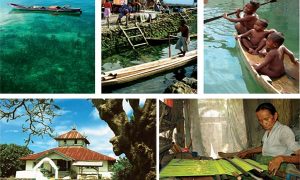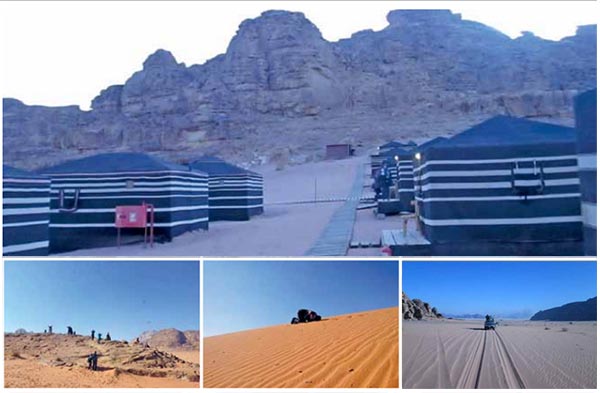
Ivory white tents with taper shaped roof looked so charming. I watched a few moments before boarding to Air Arabia. “I must have missed this country,” I muttered to myself.
A pointed-nosed youth with thick eyebrows greeted us pleasantly. He said that he has Palestinian blood. It’s just that he never returned to Palestine, even though he missed his country of origin. Now he has settled and become citizens of Jordan. Together with a stewardess, he deftly carried out his duties as a steward.
Somehow the people we met were all friendly. On the bus that took us from the waiting room to the plane, we also met a Palestinian woman. She came from Jerusalem, but lived in Amman since her husband’s nationality was Jordanian. Occasionally she took a visit to her home to meet her relatives. In English, she explained us why she could easily come in and out of Palestine where she must pass through strict inspection by the Israeli army, “Because I am a woman. It is different for the youth, especially bearded guy; he will be difficult to enter Palestine.”
“What about us? We are beardy, “asked one of his friends.
“No problem. You are safe. You can enter Jerusalem because you do not have the Palestinians blood.”
Monitor screens opened on the right and left of the cabin above our seats. Some cute boys and girls appeared on the screen. With Arabic and English they involved in small talk about how to wear a seat belt, how to use a life vest, and how to use breathing apparatus in case of force majeure. The instruction video ended with the guidance of a prayer prior to traveling (safar), after that, our plane took off from King Abdul Aziz International Airport, Jeddah, Saudi Arabia, to Queen Alia International Airport, Amman, Jordan.
A Trip to The Hashemite Kingdom Of Jordan
Just when Adzan Zhuhur (the call to Zhuhur prayer) reverberated, we arrived in Amman. A temperature of 13°C breeze gently welcomed our skins. Mahdi Yanes led us to begin the visit by reading a Safar prayer. In quite good Bahasa, he introduced to us many sides; geographical location, demographic composition, the potential of nature and life. He told the story of 20 (twenty) years ago when he went to Indonesia. So for the sake of love to Indonesia and his happiness for meeting Indonesian, Mahdi graciously gave barazek, pastry crisp contours Syrian typical wrapped with roasted sesame, honey and pistachio. Together with Ali Abu Shakra, Mahdi became our guide during in Jordan.
“Jordan has no petroleum, but it is rich in olive oil. Economic Jordan relies on cement, potassium, and sulfate. Rain only 10 (ten) times a year in Jordan. 95% of the population is Jordan Sunni Muslim. The rest is Orthodox Christians and Jews, “said Mahdi.
In line with what was said by Mahdi, we saw large olive garden along the road from the airport to the downtown of Amman. The scenery reminded me to one verse of the Qur’an, “Wat tini waz zaitun.”
We prayed jama ‘Dhuhr and’ Asr at Masjid Ahlul Kahf, Amman. The afternoon sun was quite hot, but the wind was very cold. Brrrrr … it was like ice water when we washed our hands and feet for ablution. Actually the faucet for ablution could be set to hot or cold water, but unfortunately it was not working.
Ahlul Kahf mosque had a tower with a dome on top of it. The yard was clean and spacious. There were several faucets with drinkable water in the courtyard. The prayer room for men and women were separated so we could not see each other. Near the mosque there was a hill with green trees. There were many caves built in the style of Roman architecture on the hill. One was Cave of the Seven Sleepers or Ash-habul Kahfi Cave whose story immortalized in the Qur’an in Surah Al-Kahf
Some people argued Ash-Habul Kahf Cave was in Ephesus, Anatolia, Turkey, and the bodies of the kahf young men were in Syria. However, historians agreed that Ash-habul Kahf was originally located in Amman, the place we visit.
Ash-habul Kahf Cave became the witness of the faith of 7 (seven) youths in saving Islamic values from the cruelty of the king at that time. They were accompanied by a dog named Qithmir. Allah got the kahfi youths sleeping in the cave for 309 years as proof of Allah’s majesty. When they woke up, the dog had become bones. Feeling so hungry one of them came out of the cave to buy food to the market which was not far from there. It turned out the money they had already expired. The young man went back to the cave to tell it to his friends. Arriving in the cave, Allah took their live
Our guide, Ali Abu Shakra explained, “About 100 years ago, archaeologists discovered human bones that believed to be the bones of young kahfi and dog bones in this cave. The bones of man were buried in the cave, while the dog bones were stored in one of the museum in Jordan. Archaeologists also found a market that was buried in the ground not far from this cave and found the money-coins. “
Following from the cave, we stopped to Tawaheen al-Hawa Restaurant, a Lebanese restaurant serving Middle Eastern menu. Mahdi explained, the Jordanian regularly had lunch at around 3-4 pm. It was not surprising when we entered the second floor of the restaurant and found it very was crowded. There were many tables in the room that spacious enough for 8 (eight) people. In the middle of the room there was a very beautiful crystal chandelier. The walls were adorned with paintings of artistic canvas. A male waiter with a longsleeved white shirt, black vest and a bow tie greeted visitors. From the variety of food that was served, there was no such thing called rice! The lunch cost $ 20 per person
Drizzle combined with cold temperatures in that night made our body shivering. We stayed at the Arena Space Hotel, a four star hotel in the center of Amman. Photos of King Abdullah and his Palestinian wife Rania displayed in the lobby. Ali and Mahdi told us the schedule for dinner at 8pm and breakfast at 6am. There was no rice in the menu, there were tomatoes, cucumbers, olives, cheese, cakes, boiled eggs, scrambled eggs, carrots, fresh vegetables, seeds, melon, papaya, and some types of drinks; mineral water, milk, tea, and orange juice.
After breakfast we continued the journey to Petra, it was over five (5) hours from Amman. If Amman is located in North Jordan with green field contour, then Petra is located in the South of Jordan with desert contour. Arabian Desert was surrounded us. In the middle of our way to Petra, we visited the souvenir shop in Abu Shakra to buy souvenirs, to bowel, and to pray
Petra also called with Wadi Musa, in Greek it means rock. In Arabic, it called Al Batra. Petra was famous because in there, we could find 800 individual sculptures, ancient buildings, tombs, baths, temples, arched gates and the roofed-streets that mostly carved from sandstone. Around Petra, there were many inns. When our bus entered into the parking lot, dozens of teenage Jordan girls were waving and smiling cheerfully to us. They friendly greeted us, “Hello, Indonesia! Welcome to Jordan!”
According to historical records, Petra was the capital of the Nabatean Kingdom in the time before Christ. They sculpted buildings and caves on giant rocks in that place. One of the most beautiful and large sculpture was so-called Treasury; a sculpture building resembled a palace. According to the information of Mahdi, the Nabatean sculpted Treasury from top to bottom so that the sculpture was not destroyed since the stones in that location were actually only solidified sandstone. At that time, Petra was known as a modern city that had a strong defense, the building was beautiful, and the irrigation systems were complicated or sophisticated. Ali explained, “Some people said that the caves were used to bury dead bodies. The better and more intricate carvings indicated the higher social strata. And the most magnificent sculpture is the Treasury.”
Around the Treasury there were many sellers of souvenirs of silver bracelet with the price of USD 1 per bracelet, horse-drawn carriage and camel rental for visitors
At dusk, we reached Wadi Rum (read: Wadi Ram). Wadi means valley, while Rum is the name of the tribe who inhabited the region. Wadi Rum desert is an area which is very pretty decorated proof exotic rocks. In the spring, the national flower of Jordan, Black Irish, grew up in this area. The Martian movie starring Matt Damon, which is about the planet Mars expedition, also filmed in Wadi Rum because of its red sand looks like the surface of Mars
We spent the night at Sun City Camp. The tents we used were little bit away from the main tent. The main tent was used as a dining area. Each tent occupied by 2-3 people. The road between the camp with another tent and the main tent connected with a short wooden bridge that reminded us when we crossed a wooden bridge over the River Kapuas, Pontianak. Inside the tent there were 2-3 soft beds with a thick blanket. Inside the tent there was a bathroom and toilet with hot and cold water
In the cold of the desert we were treated with cooking attraction. The sensation of taste was incredible. It was presented by the young chef wearing white gamis (an Arabian long white cloth) and red turban. After dinner, we were warmed by the fire we made near the main tent. “This is the first Indonesian group who visited Wadi Rum. People often mention PetraPetra-Petra when they visited Jordan. Sun City Camp is the most expensive camp in Wadi Rum for the bathroom is inside the camp. There is no such thing in other tents. It is small thing, but important, “said Mahdi
The temperature reached 8°C. After performing Subuh prayer, I and some friends climbed to the top of the rock in order to see the sunrise, while some friends were playing with sand and taking photographs. After finishing breakfast, we continued with the desert tour using a jeep. Each car was maximum for 6 (six) passengers. Our heart skipped a beat when the jeep we were riding suddenly down into the valley of Wadi Rum. The sensation seemed to ride a roller coaster! We were like a grain of sand in the middle stretch of desert. I wondered what would happen if we were left alone there.
That day was the last day of our visit in Jordan, the country where Prophet Yusya ‹bin Nun and Prophet Shoaib and the Companions of the Prophet Muhammad sallallaahu› alaihi wa sallam, namely Muadh ibn Jabal, ‹Abd Allah ibn Rawahah, Zaid ibn Haritha, Abu Ubaidah bin Al-Jarrah were burried. Jordan is also a country where the Companions of the Prophet Muhammad sallallaahu ‹alaihi wa sallam still alive in the form of a tree named Shahabi tree or assyajarah al-Mubarakah or a blessed tree that grows in the middle of the desert named Buqa›awiyya. Many leading scholars of this century also came from Jordan, they were Sheikh Salim bin ‹Eid Al-Hilali and Sheikh Ali bin Hasan› Abdul Hamid al-Halabi the disciples of Shaykh Muhammad Nasiruddin al-Albani rahimahullah, hadith scholars of this century.
Before leaving Jordan, we visited the Dead Sea which was located at 400 m below sea level, a place that became the lowest point in the world. Although it named «sea», the actual Dead Sea was a lake. The salt content of that sea reached 30%, contrasting with salt levels in other sea that only about 3%. For security reasons, visitors were not allowed to swim or dive in the Dead Sea, but only allowed to float on the Dead Sea. We did not worry about drowning! The high salinity made us floating. A gift that must be taken from there was the Dead Sea mud for it was the material to make cosmetic products.
Our guide, Ali and Mahdi, took us off at King Hussein Border (Allenby), the Jordan and Palestinian border. By invoking the blessings of God Almighty, that night we would continue our journey to the Aqsa Mosque, Jerusalem, Palestine, a country located on the west side of the Dead Sea. Jordan, I would miss you. One day, Inshaa Allah, I will come to visit again.
narrated by Siddiq Gandhi Staff Customs and Excise
The Hashemite Kingdom of Jordan – Temporaktif


